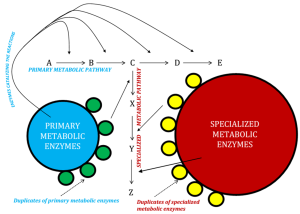The genesis of plant languages: How plants evolve new metabolic pathways from existing ones
There are an estimated 100 million species on this planet, with a stunning array of shapes, sizes, physiologies and behavior. One question that has excited evolutionary biologists since Darwin is – how does all of this biological complexity arise? Research over the last 150 years has shown that the principle of “descent with modification” proposed by Darwin, combined with the forces of natural selection and genetic drift, has a powerful effect on biological complexity. Moghe and Last (2015) discuss this principle in greater detail, in the context of the extremely diverse repertoire of plant specialized metabolism.

A schematic showing how a novel specialized metabolic pathway may get formed via recruitment of enzymes from primary metabolism and also from specialized metabolism.
Every human on earth is well-acquainted with plant specialized metabolites. The sweet smell of a basil leaf, the hotness of a chili pepper, the misty aroma of ground ginger are all due to plant chemicals generally known as specialized metabolites. These compounds are different from “primary metabolites” such as amino acids, carbohydrates and fatty acids (although derived from them), in that they may not be essential for plant growth and are not uniformly present across all plants. Although not essential, specialized metabolites are still important. Plants produce these compounds for communicating with other life around them – their pollinators, the insects that feed on their leaves, the micro-organisms that inhabit the soil around them, and other plants in the vicinity. Thus, plant specialized metabolism constitutes the language of the plant world, and with >200,000 specialized metabolites known across all plants, it undoubtedly is a highly diverse form of language.
Moghe and Last (2015) discuss how divergence between closely related genes can play a role in the generation of novel metabolic pathways for new classes of specialized metabolites. They describe the various mechanisms by which enzymes that have been involved in primary metabolism for hundreds of millions of years duplicate, and give rise to new enzymes with novel functions. These new enzymes have been instrumental in producing novel classes of specialized metabolites such as glucosinolates, acylsugars, terpenoids and some alkaloids that are unique to certain plant families. The new enzymes started their lives as one of the copies of a duplicated primary metabolic gene, and subsequently underwent changes in transcriptional or allosteric regulation, in their active sites, or in protein-protein interactions to evolve novel activities. For example, the isopropylmalate synthase (IPMS) enzyme, which is involved in biosynthesis of the amino acid leucine, was recruited independently at least twice into specialized metabolism in different plant lineages, via loss of the C-terminal domain of the protein, causing changes in its allosteric regulation. Such recruitment may be associated with positive selection, as seen for the methylthioalkylmalate synthases (MAMs) involved in glucosinolate biosynthesis in plants like cabbage and mustard.
Emergence of such novel activities helps in explaining a portion of the extensive metabolic variation we see across the plant world. Most likely, a fully functioning pathway will also need to have multiple enzymes coming together to produce a functionally beneficial compound. How this is achieved is an exciting area for further exploration. Another question is whether there are some enzymes that are more malleable to structural and functional changes? Because if such enzymes existed, it would be possible to engineer such enzymes to produce novel products not yet recorded in the plant world. Future research into the characterization and evolution of specialized metabolic pathways holds the key to addressing these questions.
Moghe GD
Department of Biochemistry and Molecular Biology and Department of Plant Biology,
Michigan State University, East Lansing, Michigan
Publication
Something Old, Something New: Conserved Enzymes and the Evolution of Novelty in Plant Specialized Metabolism.
Moghe GD, Last RL
Plant Physiol. 2015 Nov
Related Articles:
 | Does UV-B radiation modify gene expression? Frequently the harsh environmental conditions, such as, high temperatures, low freezing conditions, high levels of PAR and UV-B sun radiation induce remarkable adaptive reactions in plants. These responses suggest that… |
 | From complexity to simplicity via microbial division… If someone were to put Nature under a microscope, it would become obvious that microbes are present in all environments on our planet. Microbes are often forced to interact within… |
 | Mortality attributable to influenza, evidence and… In the last recent years, before the Covid-19 pandemic, influenza-attributable mortality has been impressive, in particular among elderly aged 65 years. A wide variability between different countries, seasons, and years… |
 | Plant digestive juice: replenish or not? Carnivorous tropical pitcher plants from the genus Nepenthes produce elaborate pitcher organs with digestive glands to trap and digest insect prey in nitrogen poor soil. The content of pitcher fluids… |
 | Historical stability of the human aging rate and its… Using age-related mortality data for 40 countries, it is shown that the rate of aging does not change significantly over history and is almost the same for different countries from… |
 | The stress of dieting: what a rat model may tell us… In the United States, obesity and concomitant diseases such as hypertension and diabetes have soared in older adults—and obesity is especially pronounced in women after menopause. Numerous strategies are used… |







Leave a Reply
You must be logged in to post a comment.